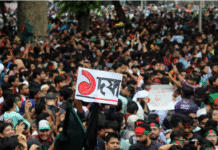Finally, the barbaric regime of Myanmar has been put on the dock and found guilty of the crime of all crimes: genocide. The verdict was delivered on the last day of the final session of the Permanent People’s Tribunal (PPT) on alleged state crimes against the Rohingya, Kachins and other ethnic minority groups on September 22 in Kuala Lumpur after three days of deliberations. In the opening session held in London in March this year, following preliminary hearings on the complaints of Kachins, Rohingyas and other Muslim populations in Myanmar, the court convened this final hearing.
The tribunal, comprised of eminent jurists, genocide scholars and those involved in past genocide trials, heard testimonies of a number of survivors, members of victims’ families, witnesses and expert witnesses. Oral testimonies, documents and records, including those of the Burmese government and the military (retrieved from archival sources of different countries), and visual materials (photographs and video footages) were presented before the tribunal.
Although symbolic, the verdict has major significance. For the first time, a conclusion has been drawn by competent authorities following thorough examination of facts and rigorous legal scrutiny: “The State of Myanmar is guilty of the crime of genocide against the Rohingya group.” It went on to observe that “genocide against the Rohingya is now taking place with ongoing acts of genocide and the possibility the casualties of that genocide could be even higher in the future if nothing is done to stop it.” This essay argues that despite overwhelming evidence there has been a palpable reticence of the international community to call it genocide.
The international community refused to acknowledge that the Burmese state’s intent and actions were systematically directed to dismantle the structures of protection that the Rohingyas enjoyed until the martial law regime of General Ne Win in 1962. Jettisoning the country’s pluralist and secularist practices from the get-go, the military government was hell-bent on ridding the country of the Rohingya population. 1978 witnessed the brutal execution of that intent when about 280,000 were driven out of Arakan with the launch of Operation Naga Min, or Operation King Dragon. The 1978 exodus was not the outcome of any communal strife between the Buddhist Rakhines and the Rohingya Muslims in Arakan. It was the result of a deliberate policy of banishing an ethnic minority from their ancestral habitat by the Burmese state.
Within months of their arrival in Bangladesh, Myanmar (then Burma) had to concede to Bangladesh’s demand of taking back the Rohingyas who by law were still its citizens. By the subsequent enactment of the 1982 Citizenship Law, Rohingyas were stripped of their rightful status. In pursuit of its genocidal agenda the Burmese state crafted a comprehensive policy to destroy the Rohingya identity by systematically denying the community members to live in dignity and pursue their faith and cultural traditions. Since then a plethora of laws, regulations and administrative orders have been passed and institutions such as the infamous security force Nasaka were created—subjecting the Rohingyas to what a witness during the Kuala Lumpur trial termed as “sub-human”. Despite the absence of any looming threat, the northern Arakan region was gradually turned into a militarised zone. Its Muslim residents have been subjected to degrading treatment, discrimination, torture, forced labour, forced relocation, and arbitrary taxes, and denied opportunities to practise their faith and culture and access justice. As a logical follow-up to such “systematic weakening” another state-sponsored mass flight was orchestrated in 1992 resulting in 250,000 Rohingyas seeking refuge in neighbouring Bangladesh. The international community still chose to look the other way, remaining resolute in its denial mode.
Shrewd Burmese generals by then framed the project of depopulating Arakan of Rohingyas—not by brute force (that would draw international media attention and condemnation) but by creating conditions in which sustaining life became impossible. This resulted in slow and incremental outward movement of Rohingyas in small groups since 1992. Their number cumulatively stood at 300,000 in Bangladesh until the unfolding of events following August 25, 2017. In the interim, spikes in violence in Arakan shored up the number of incoming refugees.
Little effort was given to find out what prompted the cross-border movement of the Rohingyas. Compassion fatigue for the residual caseload of 23,000 registered refugees living in camps (the number by now swelled to 31,000) evoked little interest of the outside world towards the “most persecuted minority of the world”. The Rohingyas’ claim to secure international protection was perhaps further constrained by the fact that unlike Iraq and Libya, Arakan remains void of black gold. In the headquarters of international agencies in New York and Geneva and national capitals of concerned countries, it was perhaps a conscious choice to not confront the bitter truth of enduring genocide since it would necessitate urgent international action. Despite the ongoing genocide, Rohingyas were left to face the vicious state forces quite like their poor cousins in Burundi and Rwanda.
By foot-dragging over the issue of recognising the Burmese government’s acts as genocide, powerful states and international actors—who champion rule of law, democracy and freedom, and human rights—allowed the murderous Burmese army to act with impunity in implementing its long-drawn-out genocidal agenda on the Rohingyas. The international community’s denial also contributed to the Burmese military’s decision for the “final solution” of the Rohingya question that the world is now faced with. There appears to be a striking similarity between Neville Chamberlain’s policy of appeasement of Nazi Germany and that of these entities’ strategy of placating the Burmese military.
The heart-wrenching testimonies and video footages presented before the tribunal convinced the judges in no uncertain terms what Raphael Lemkin, the Polish lawyer who coined the term “genocide”, meant: “Destruction of a nation or an ethnic group.” The tribunal concurred with Lemkin that in the Rohingya case, the national identity of the oppressed group was destroyed and national identity of the oppressor was imposed. The Rohingya case also sufficiently meets renowned genocide scholar and Genocide Watch’s President Gregory Stanton’s ten conditions of genocide: classification, symbolisation, discrimination, dehumanisation, organisation, polarisation, preparation, persecution, extermination and denial. Stanton reminds us that these stages are predictable but not inexorable, and the process is not linear. Most importantly, “at each stage, preventive measures can stop it.”
In their rush to embrace the once-pariah state of Myanmar, the powerful countries expediently sacrificed the Rohingyas at the altar of strategic and commercial interests, and international organisations hid behind the façade of intricacies of legal interpretations. Their usage of the term “ethnic cleansing”, a term that has no place in international law, is a scheme to not state the fact. As Daniel Feierstein, the chair judge of the PPT, poignantly reminded the court, “It’s a concept created by the perpetrator Slobodan Miloseviç.” It’s a shame that the world is resorting to the perpetrator’s language to justify its inaction.
Days ago, the UN Secretary-General, in response to a question about whether he agreed with UN Human Rights Chief Zeid Ra’ad al-Hussein that what’s happening in Rakhine State is ethnic cleansing, retorted back to the journalist saying, “When one-third of the Rohingya population had to flee the country, can you find a better word to describe it?”
Yes, Mr Secretary-General, it’s the G word.
Source: The Daily Star









